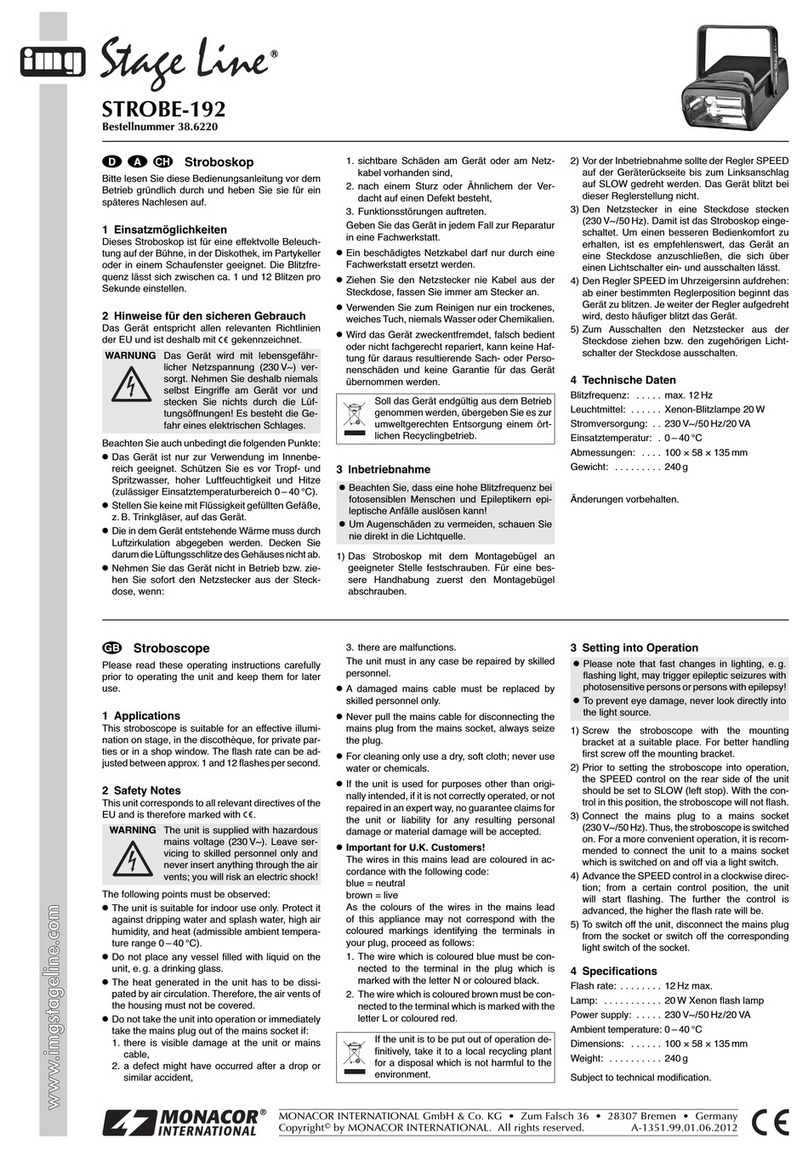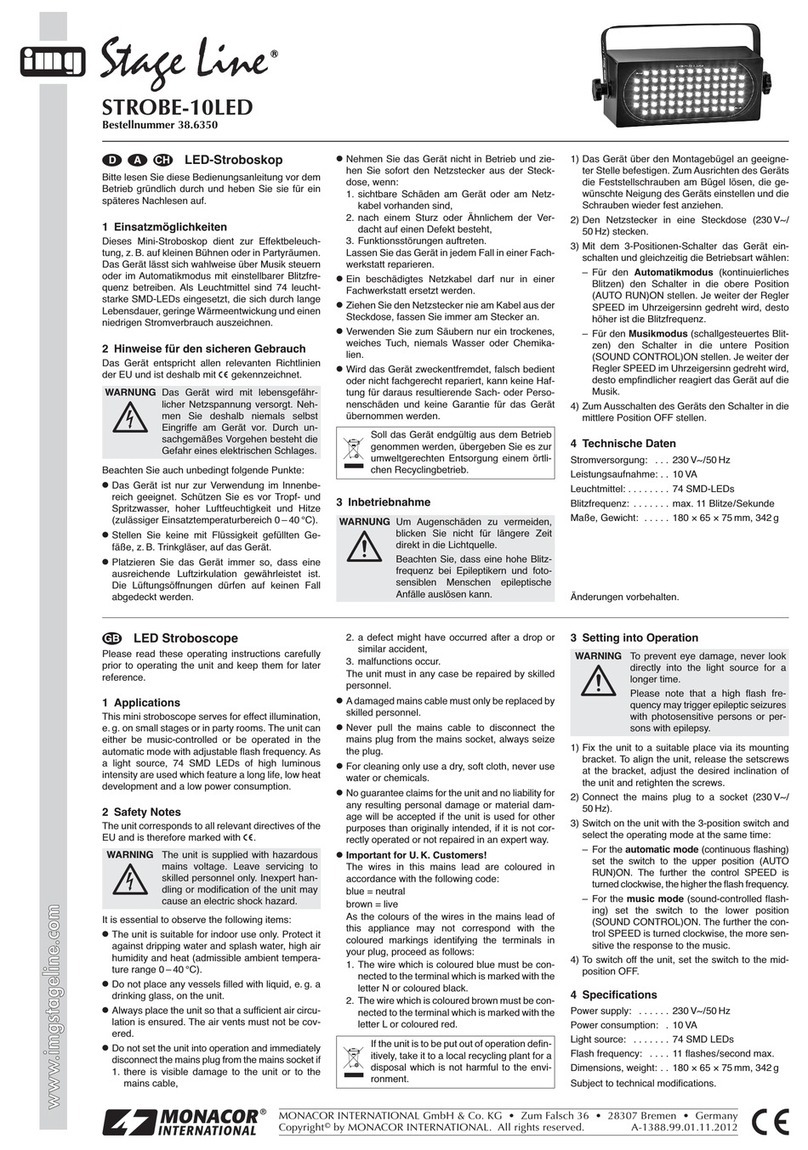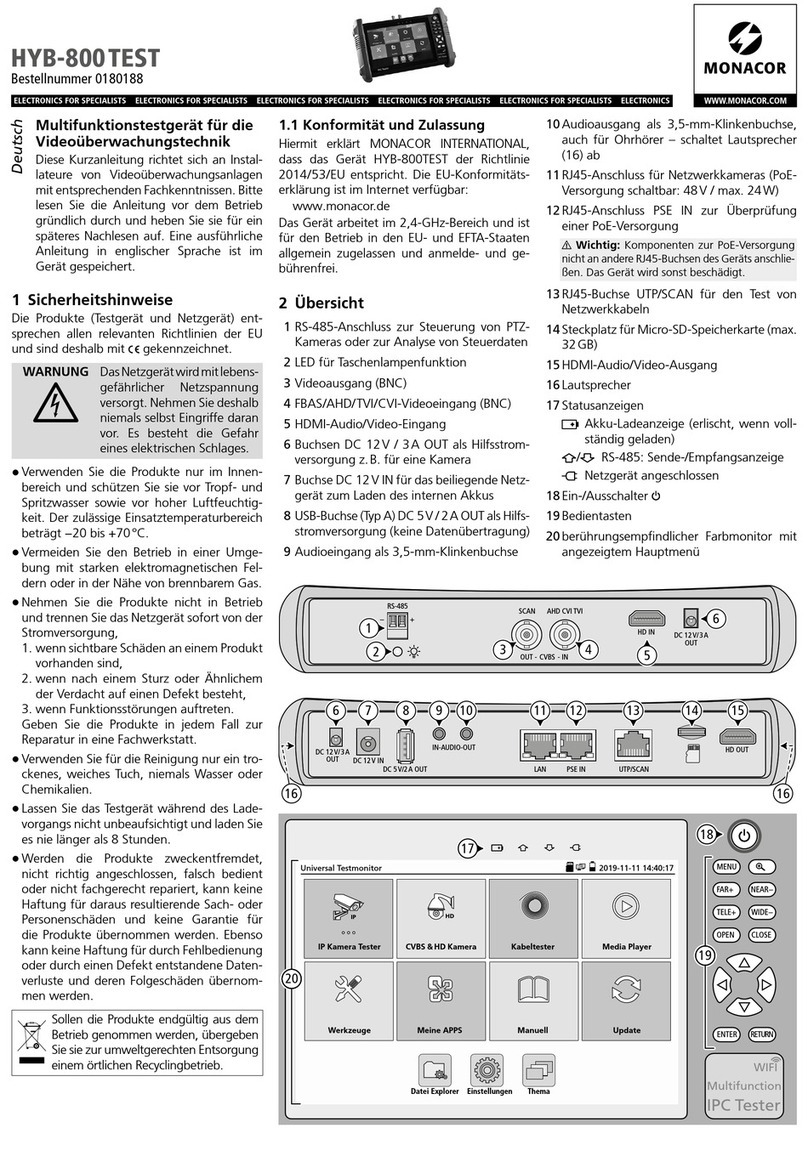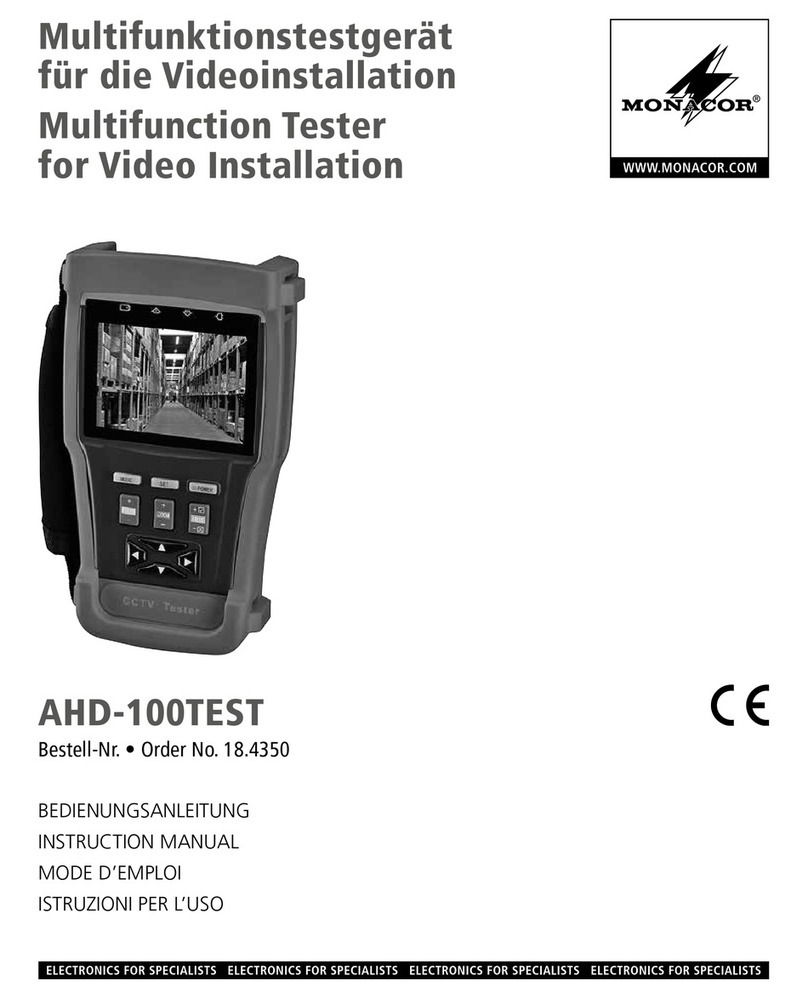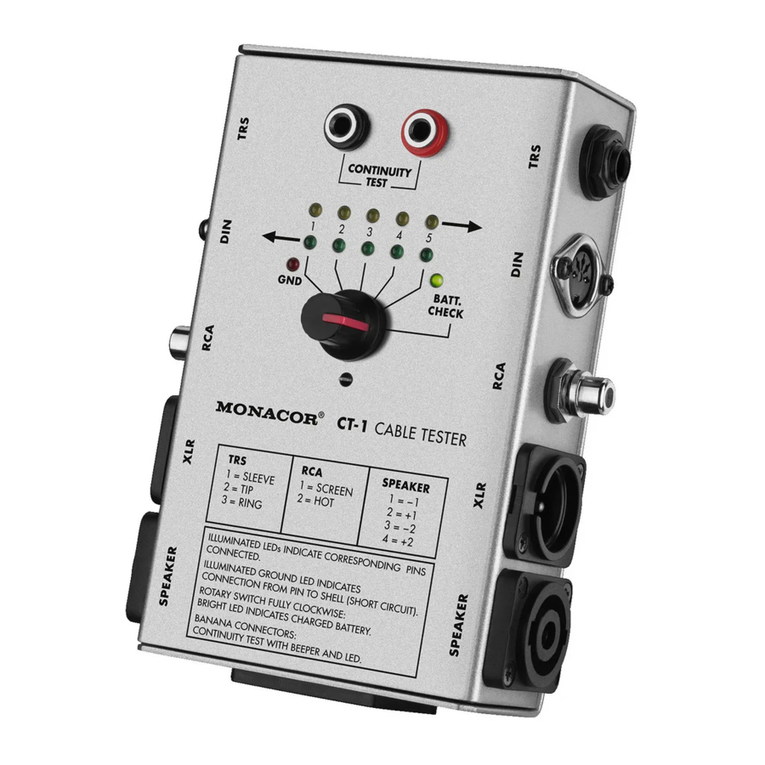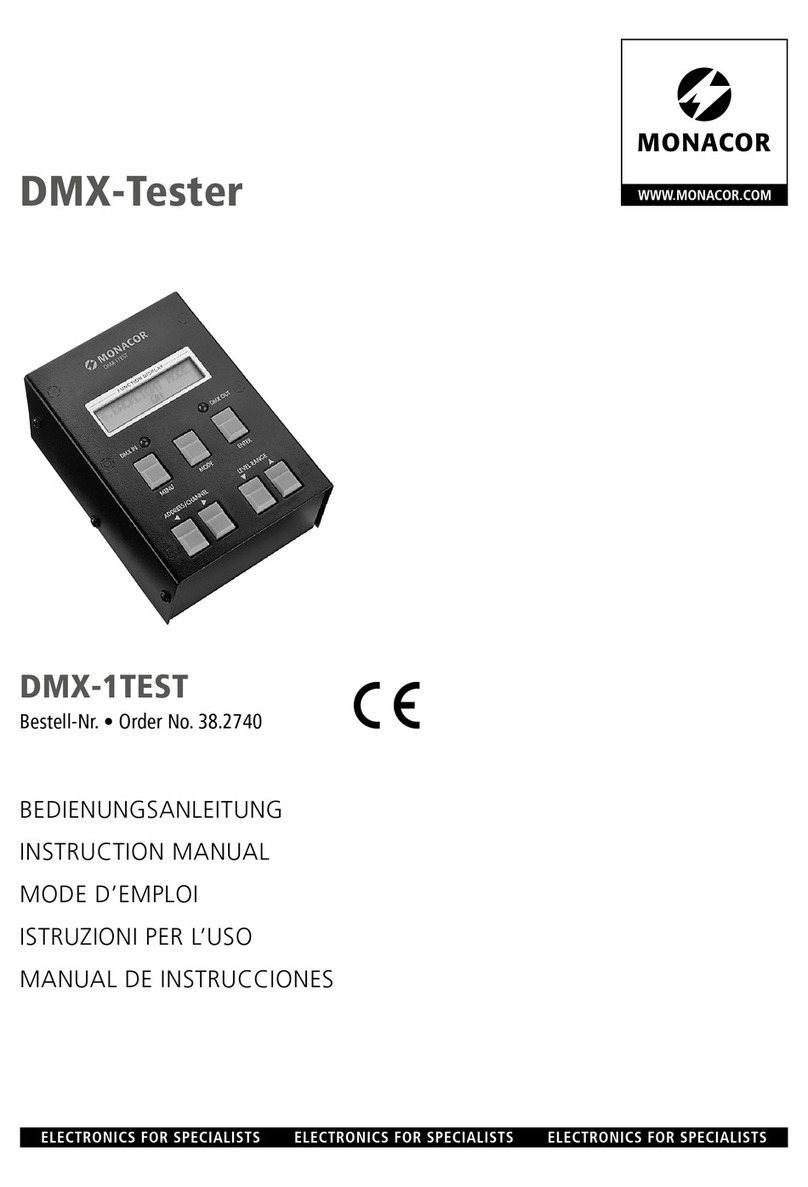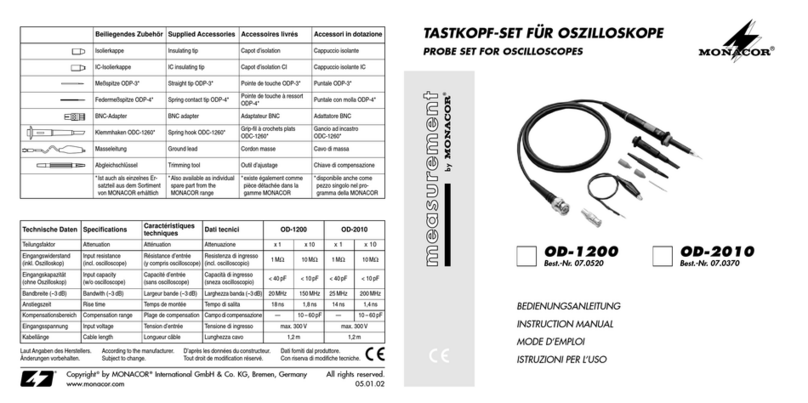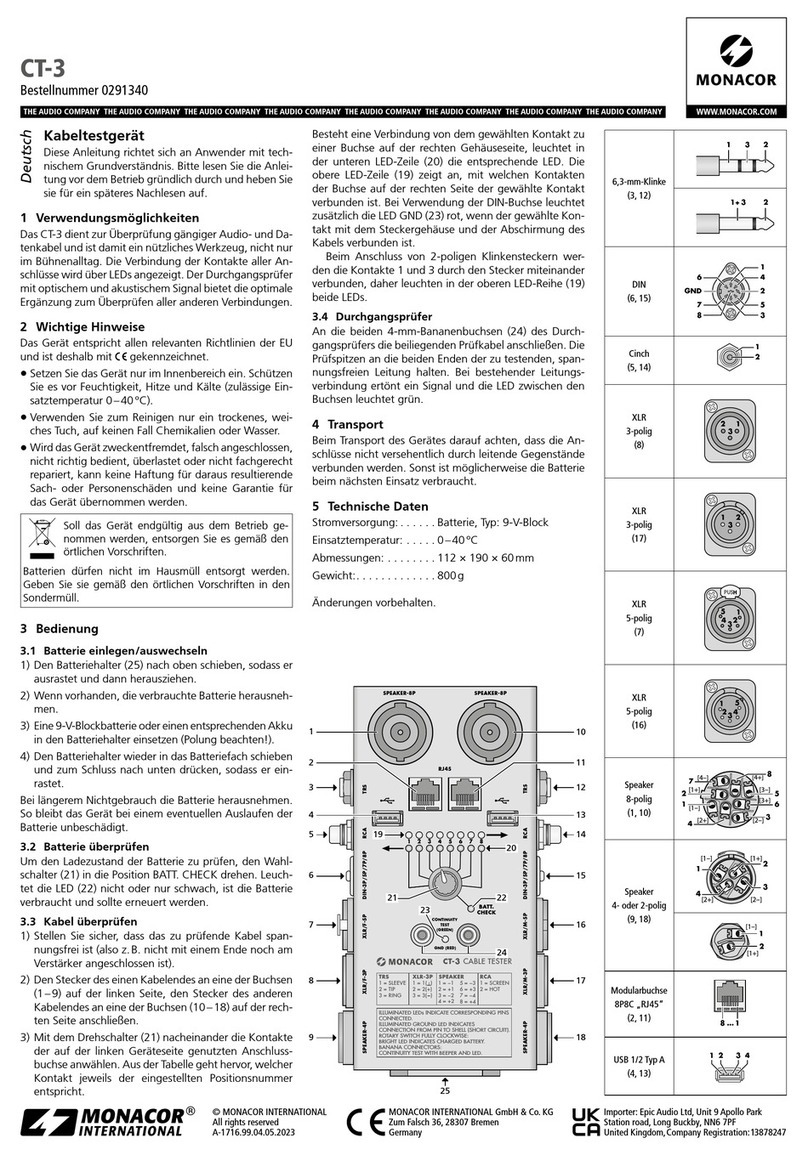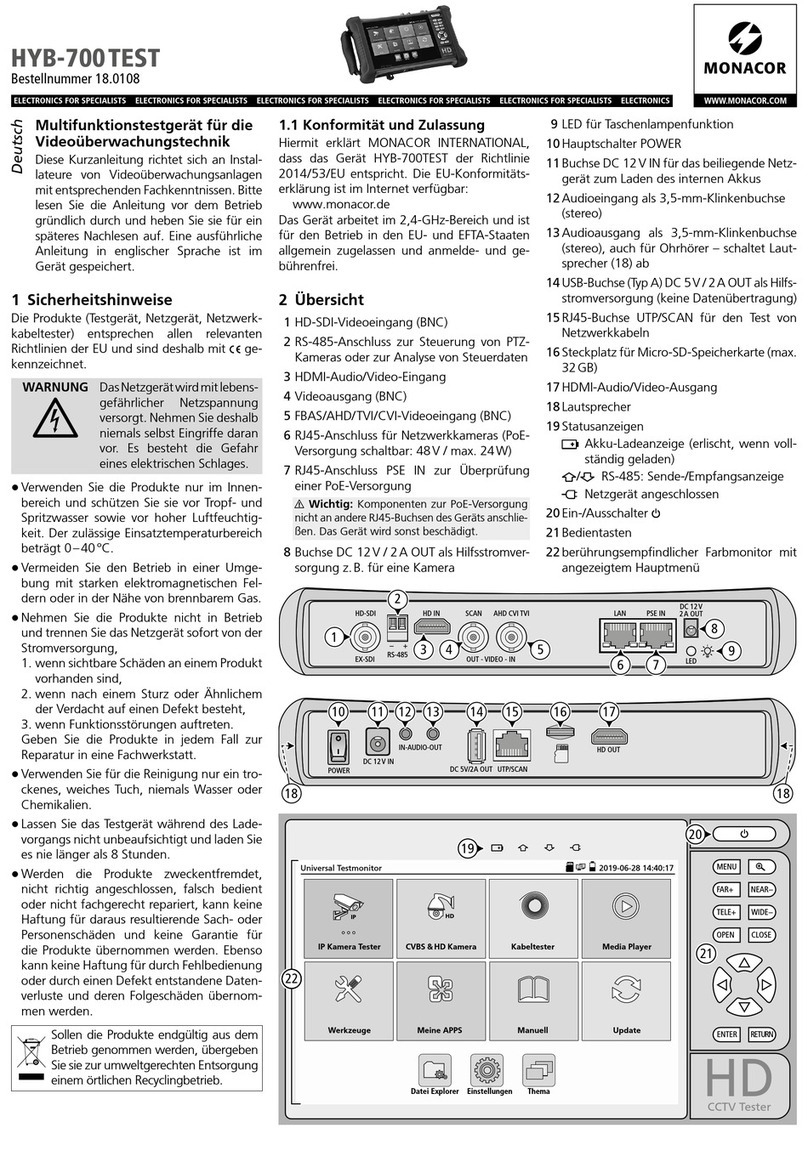
ELECTRONICS FOR SPECIALISTS ELECTRONICS FOR SPECIALISTS ELECTRONICS FOR SPECIALISTS ELECTRONICS FOR SPECIALISTS ELECTRONICS FOR SPECIALISTS ELECTRONICS
MONACOR INTERNATIONAL GmbH & Co. KG • Zum Falsch 36 • 28307 Bremen • Germany
Copyright©by MONACOR INTERNATIONAL. All rights reserved. A-1862.99.01.09.2017
CTG-1NOISE Référence num.• Codice 29.2050
CTG-1SINE Référence num.• Codice 29.2060
Tester delle funzioni
nel connettore XLR
Queste istruzioni sono rivolte agli utenti
con conoscenze base nella tecnica audio. Vi
preghiamo di leggerle attentamente prima
della messa in funzione e ci conservarle per
un uso futuro.
1 Possibilità d’impiego
Conoscete questa situazione? Il microfono sul
palcoscenico non dà nessun segnale al posto
FoH e dovete trovare il difetto. È il microfono o il
cavo? È il multicore o il canale della consolle? Un
ohmmetro non avete a portata di mano oppure
la sua batteria è scarica.
La soluzione di MONACOR: Inserite semplice‑
mente il CTG nel cavo del microfono, attivate
l’alimentazione phantom e il tester vi farà vedere
il difetto. Il CTG è disponibile con un generatore
di rumore rosa (‑1NOISE) o con un generatore di
tensione sinusoidale di 100Hz (‑1SINE).
2 Avvertenze importanti per l’uso
Il tester è conforme a tutte le direttive rilevanti
dell’UE e pertanto porta la sigla .
•
Il tester è previsto solo per l’uso all’interno di
locali. Proteggerlo dall’acqua gocciolante e
dagli spruzzi d’acqua nonché da alta umidità
dell’aria. La temperatura d’esercizio ammessa
è 0– 40°C.
•
Per la pulizia usare solo un panno morbido,
asciutto; non impiegare mai acqua o prodotti
chimici.
•
Nel caso d’uso improprio, di collegamenti sba‑
gliati o di riparazione non a regola d’arte del
tester, non si assume nessuna responsabilità
per eventuali danni consequenziali a persone
o a cose e non si assume nessuna garanzia
per il tester.
Se si desidera eliminare il tester defi‑
nitivamente, consegnarlo per lo smal‑
timento ad un’istituzione locale per il
riciclaggio.
3 Funzionamento
1) Mettere in muto l’impianto audio.
2) Impostare il canale del mixer con il segnale
mancante secondo la fonte dei segnali (micro‑
fono, strumento ecc.) e attivare l’alimenta‑
zione phantom.
3) Al posto della fonte dei segnali, collegare il
tester con il cavo audio.
4) Il LED sul tester lampeggia oppure si accende
secondo il difetto trovato:
LED Stato
lampeggia 2 × cavo al pin 2 interrotto
lampeggia 3 × cavo al pin 3 interrotto
non si accende cavo al pin 1 interrotto oppure
alimentazione phantom assente
rimane acceso
segnale del generatore presente:
come controllo rimettere l‘audio
dell‘impianto audio; si dovrebbe
sentire il segnale del generatore.
Controllare la fonte dei segnali!
4 Dati tecnici
Segnale d’uscita
CTG‑1NOISE:.. . . . . rumore rosa
CTG‑1SINE: . . . . . . sinusoidale 100Hz
Livello: . . . . . . . . . . ca. 100mVPP
Contatti:. . . . . . . . . . XLR, bilanciato
pin 1 = massa
pin 2 = segnale +
pin 3 = segnale –
Indicazione difetto: . . tramite LED
Alimentazione: . . . . . alimentazione phantom
9– 48V (⎓)
Dimensioni:. . . . . . . . ⌀19mm × 74 mm
Peso:. . . . . . . . . . . . . 32 g
Corpo: . . . . . . . . . . . connettore XLR NEUTRIK
Testeur de fonctionnement
dansfiche XLR
Cette notice s’adresse aux utilisateurs avec
des connaissances de base en audio. Veuillez
lire la présente notice avec attention avant le
fonctionnement et conservez‑la pour pou‑
voir vous y reporter ultérieurement.
1 Possibilités d’utilisation
Vous connaissez la situation ? Le microphone sur
scène n’émet aucun signal vers le public et vous
devez trouver d’où vient le problème. Est‑ce le
microphone ou le câble ? Est‑ce le multiconduc‑
teurou le canal de la table de mixage? Vous
n’avez pas d’ohmmètre sous la main ou la bat‑
terie est vide.
La solution de MONACOR : branchez tout sim‑
plement le CTG au cordon micro, allumez l’ali‑
mentation fantôme et le testeur indique l’erreur.
Le CTG est disponible avec un générateur de
bruit rose (‑1NOISE) ou avec un générateur de
100Hz sinus (‑1SINE).
2 Conseils importants d’utilisation
Le testeur répond à toutes les directives néces‑
saires de l’Union européenne et porte donc le
symbole .
•
Le testeur n’est conçu que pour une utilisation
en intérieur. Protégez‑le de tout type de pro‑
jections d’eau, des éclaboussures et d’une hu‑
midité élevée de l’air. La plage de température
de fonctionnement autoriséeest de 0– 40°C.
•
Pour le nettoyage, utilisez un chiffon doux
et sec, en aucun cas d’eau ou de produits
chimiques.
•
Nous déclinons toute responsabilité en cas de
dommages matériels ou corporels résultants si
le testeur est utilisé dans un but autre que celui
pour lequel il a été conçu, s’il n’est pas cor‑
rectement branché ou s’il n’est pas réparé par
une personne habilitée; de même, la garantie
deviendrait caduque.
Lorsque le testeur est définitivement
retiré du service, vous devez le déposer
dans une usine de recyclage adaptée
pour contribuer à son élimination non
polluante.
CARTONS ET EMBALLAGE
PAPIER À TRIER
3 Utilisation
1) Coupez le son de l’installation audio.
2) Réglez le canal de la table de mixage sur
lequel le signal est absent, en fonction de
la source de signal (micro, instrument ...) et
allumez l’alimentation fantôme.
3) Reliez le testeur au cordon audio à la place de
la source de signal.
4) La LED sur le testeur clignote ou brille selon
l’erreur constatée :
LED Etat
clignote 2 × câble au pin 2 interrompu
clignote 3 × câble au pin 3 interrompu
ne brille pas câble au pin 1 interrompu ou
alimentation fantôme manquante
brille en continu
le signal du général existe : pour
le contrôle, activez le son de
l‘installation audio : le signal du
générateur devrait être audible.
Vérifiez la source de signal !
4 Caractéristiques techniques
Signal de sortie
CTG‑1NOISE:. . . . . bruit rose
CTG‑1SINE: . . . . . . 100Hz sinus
Niveau: . . . . . . . . . 100mVCC environ
Branchements:. . . . . XLR, symétrique
pin 1 = masse
pin 2 = signal +
pin 3 = signal −
Indication d’erreur: . via LED
Alimentation:. . . . . . alimentation fantôme
9– 48V (⎓)
Dimensions:. . . . . . . ⌀19mm × 74 mm
Poids:. . . . . . . . . . . . 32g
Corps: . . . . . . . . . . . fiche XLR NEUTRIK
Tout droit de modification réservé.
FrançaisItaliano
Con riserva di modifiche tecniche.


